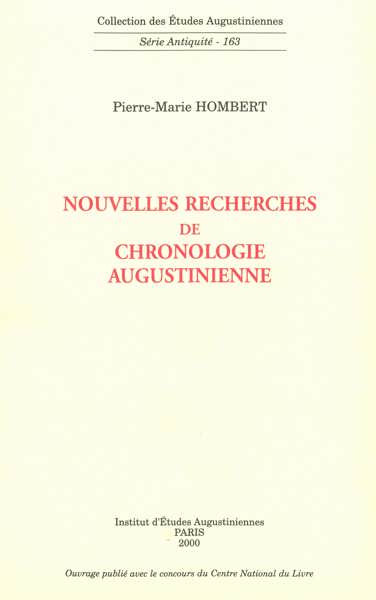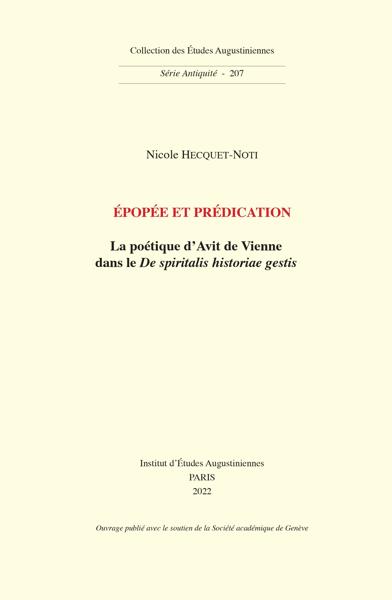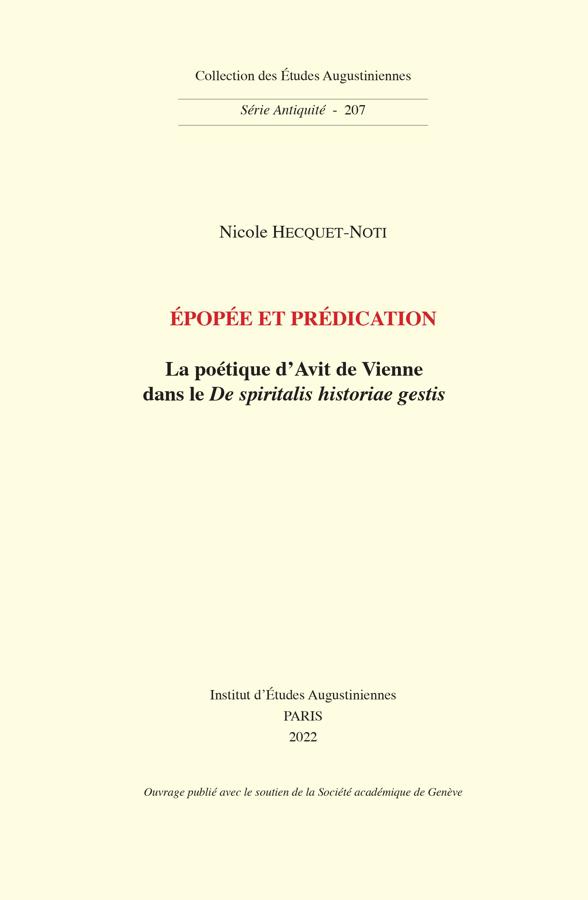
Épopée et prédication
La poétique d’Avit de Vienne dans le De spiritalis historiae gestis
Nicole Hecquet-Noti
- Pages: 334 p.
- Size:165 x 250 mm
- Illustrations:25 tables b/w.
- Language(s):French, Latin
- Publication Year:2022
- € 46,00 EXCL. VAT RETAIL PRICE
- ISBN: 978-2-85121-318-1
- Paperback
- Available
“Au total, N. H.-N. offre ici à la communauté scientifique un livre qui sera désormais la référence pour toute étude ultérieure sur la poésie d’Avit de Vienne, où esthétique et théologie se confondent pour rendre témoignage au mystère de la parole divine.” (Paul-Augustin Deproost, dans Revue d’Histoire Ecclésiastique, 119/1-2, 2024, p. 323)
“A leitura de Necquet-Noti permite-nos romper as fronteiras temporaisque poderiam constranger este texto e comungar deste itinerário simultaneamentepoético e espiritual.” (Paulo Ramos, in Euphrosyne. Journal for Classical Philology, 51, 2023, p. 511)
Avitus of Vienne is the author of the five poetic books of the Spiritual History celebrating the importance of Christ in baptismal catechesis by the glorification of the patriarchs Adam, Noah and Moses. Catholic bishop belonging to the Gallo-Roman aristocracy, Avitus is a man of great classical learning. The present study examines Avitus’ poetic style, by combining a narratological approach with the methods of traditional philology. This analysis highlights the importance of the two auctorial voices constructing the poem: the voice of the bishop, formed by the practice of the liturgy of the Word, and the voice of the poet, steeped in rhetoric and paying tribute to classical poetics. These crossing voices produce a poem accessible to a large audience, whether contemporary or posterior to the 6th century – we know that the poem has enjoyed a wide circulation during the Middle Ages. Secondly, the analysis focuses on the construction of the poetic narrative, explores the adaptation of the epic codes to the transmission of the Christian faith and emphasizes Avitus’ debt to the Latin epic poets. Finally, the stylistic and metrical study proves the perfect mastery he has of the hexameter.
Avit de Vienne est l’auteur des cinq chants de l’Histoire spirituelle, qui célèbre l’importance du Christ dans la catéchèse baptismale, par la glorification des patriarches Adam, Noé et Moïse. Évêque catholique appartenant à l’aristocratie gallo-romaine, Avit est un lettré d’une grande culture latine. La présente étude examine son écriture poétique au moyen d’une approche narratologique croisée avec les méthodes de la philologie traditionnelle. Il en ressort l’importance des deux voix auctoriales construisant le poème : la voix de l’évêque, formé par la pratique de la liturgie de la Parole, et celle du poète, pétri de rhétorique et rendant hommage à la poétique classique. Ce mélange des voix auctoriales produit un poème accessible à un large public, contemporain mais aussi postérieur au VIe s. – le poème connaîtra une grande diffusion au Moyen Âge. L’analyse proposée permet de saisir la construction du récit poétique, de montrer l’adaptation des codes épiques à la transmission de la foi chrétienne et de souligner la dette d’Avit envers les poètes épiques latins. Enfin, l’étude stylistique et métrique prouve la parfaite maîtrise de l’hexamètre de la part du poète chrétien.
Avant-propos
Introduction : L’homme et l’œuvre
Première partie : Les instances énonciatives
Chapitre premier. Dualité du narrateur premier
Chapitre II. Réception du poème : destinataires et lecteurs
Conclusion : L’utilitas poétique
Deuxième partie : Structure et récit épiques
Chapitre premier. Unité globale et composition épisodique
Chapitre II. Principaux constituants : les discours
Chapitre III. Les excursus descriptifs
Chapitre IV. La narration principale
Troisième partie : Intertextualité et style
Chapitre premier. Avit lecteur des poètes classiques
Chapitre II. Austérité stylistique et licentia poetarum
Chapitre III. Un maniérisme formel ? Rythme et prosodie
Conclusion générale
Annexes
Indices




